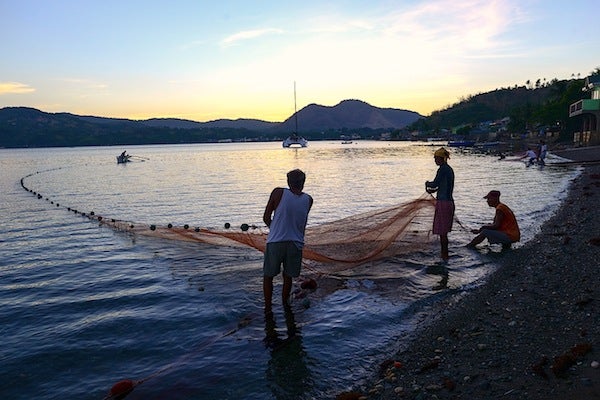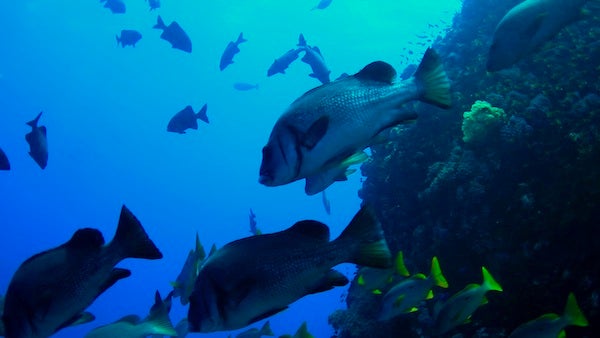This article was published in Scientific American’s former blog network and reflects the views of the author, not necessarily those of Scientific American
Editor’s Note: “The Richest Reef” follows members of a scientific dive team as they attempt to pinpoint the center of the most biologically diverse marine ecosystem in the world. Long considered our planet’s most species-rich piece of ocean real estate, the Western Pacific’s “Coral Triangle” is a continent-sized patchwork of habitats, populations, and communities. Expedition scientists are trying to identify exactly which section of this rich mosaic is most diverse, but their effort carries with it far more meaning than a simple dot on a map would suggest. Along the way, they’ll discover dozens of new species, visit dive sites and depths no one has seen before, and gain a better understanding of the factors that promote biodiversity and the role these species-rich areas play in sustaining healthy ecosystems. See below for a list of all posts in the series.
Given the stunning diversity and abundance I’ve seen here, I feel almost ungrateful bringing this up, but I’ve started to notice a profound absence. It seems that all the predators have gone missing from the Verde Island Passage.
By “predators,” I don’t mean animals that eat other animals—there are plenty of those. I’m referring to the types of creatures we typically think of when we hear that muscular three-syllable word—the kind with teeth, and mass, and the sort of opportunistic movements that send a rush of adrenaline through your system when you see them in open water.
On supporting science journalism
If you're enjoying this article, consider supporting our award-winning journalism by subscribing. By purchasing a subscription you are helping to ensure the future of impactful stories about the discoveries and ideas shaping our world today.

Fishermen near Anilao on the south coast of Luzon hauling in their nets at daybreak.(Photo by Luiz Rocha)
I’m talking toothy barracudas and groupers, heavy-bodied marine mammals, and, yes, sharks. So far, in this, the most biologically diverse marine ecosystem on the planet, I can count the number of large predators I’ve seen on zero fingers. It’s like someone or something came along and gathered up all the size-large bodies and left behind this breathtaking diversity of smalls and mediums.
So it’s with that observation and my curiosity about why this might be—as opposed to any lack of appreciation—that I ask Terry Gosliner, a curator at the California Academy of Sciences and one of the scientific leads on this expedition, where have all the predators gone?
“It’s really one of the things that’s most concerning,” he says “We’re looking at a dramatically altered environment, one that’s devoid of apex predators.”
Gosliner estimates that he’s seen only two or three sharks in his 20 years of conducting research in the Philippines. He’s spent so much time in the water here not seeing large predators that he’s no longer surprised by the observation, but he isn’t about to pretend that it’s natural. Other scientists and locals with an even longer history in the region than his describe a past abundant with sharks and other large fish.
Not surprisingly, fishing pressure is largely responsible for the steep decline in populations of sharks and other predatory fish in the Verde Island Passage. This is not large-scale, high-tech, commercial fishing. Local fishermen primarily use what the scientists call “artisanal methods.” As quaint as these might sound, the techniques are shockingly effective when multiplied by the staggering number of Filipino hands that employ them. “The number of little fishing canoes is just mind blowing,” says Luiz Rocha, the Academy’s curator of ichthyology and a member of the “twilight zone” dive team I wrote about in an earlier post. “We see fishing lines everywhere, even on the deep reefs.” And what Filipino fishermen don’t catch with hook and line, they scoop up with fish traps and gill nets.
Sharks are particularly vulnerable to fishing pressure, Rocha says. Not only are they relatively easily caught, but they also reproduce very slowly. “When you remove a shark, it’s going to be ten years for its replacement to come back,” he says.

A mixed school of predatory fish—sweetlips, jacks, and snappers—patrols the edge of the “Pinnacle” off Verde Island’s northeast coast. (Photo by Will Love)
And after the sharks and other large fish are gone, out of necessity, fishermen simply move down to the next trophic level in the food chain—in this case, the schools of medium-sized fish like jacks and sweetlips that cruise the perimeter of today’s healthiest Philippine reefs.
As altered as the environment may be without its natural compliment of apex predators, the immediate concern for this team and their conservation partners is preserving what’s left, and preventing an uncontrollable slide into decline. According to Gosliner, “If you remove all the predatory fish, you’re only going to have herbivorous damselfish and if those get overfished, you’re basically going to have algae overgrowing corals and that’s when the whole system crashes, if not before.”
Fortunately, we’ve not reached that chapter of the story yet, and we’ll hopefully skip it altogether. The scientists point to clear signs of ecosystem resilience, if not recovery, in several areas here. One of the success stories they point to most often is the “Pinnacle,” a site at Verde Island’s northeast tip. This is where the team has consistently seen the largest fish and the greatest abundance of those fish—the twilight zone team even caught a rare glimpse of a pair of thresher sharks on one of their dives in April.
What’s interesting about the ecological health around the Pinnacle and Verde Island in general is that this place isn’t protected by government regulation. Instead, it’s the area’s strong currents, depth and remoteness that provide refuge for fish large and small. Because the waters here are considered too distant or too dangerous by most local fishermen to bother with, the sizable populations of larger fish have been able to hang on or make a comeback. But this circumstantial refuge speaks to the importance of protecting waters that are closer to population centers and easier to fish.

Several generations of Verde Island residents hear about the biological riches that expedition scientists are finding near their homes, and why this ecosystem is important to protect. (Photo by Steven Bedard)
In most cases, protection means the establishment of marine protected areas (MPAs). Although a number of these sanctuaries dot the Philippine coastline, both Gosliner and Rocha say that there are not enough of them and that they are too small to effectively sustain populations of large fish. “There’s no long stretch of protected coastline, because so much of the economy depends on coastal fishing,” Rocha says. “Most reserves are smaller than a grouper’s home range,” so invariably these large fish have to venture beyond the sanctuary’s boundaries, where fishermen know to set their nets and lines.
The pressing need for greater protection of larger tracts is the reason nearly all of the scientists have spent a significant portion of their time on this expedition sharing with local communities what they’ve found and what they know about the richness of the marine environment here as well as the threats they face. Gosliner knows from experience that outreach with groups of all ages is one of the best tools they have of changing the local communities’ hearts and minds about conservation.
But as Rocha points out, ways of life are deeply rooted here, and change won’t take place overnight. “We can come here and say that they should set out 1,000 square miles of reef, but then we see what they eat,” he says. “What are they going to eat if they don’t fish?” Indeed, the challenge is to demonstrate that the value of protecting these tremendous natural resources is greater than the value of exploiting them.
In the next and final post of this series, we’ll look at what goes into deciding which organisms should be collected for research purposes and which should be left behind. We’ll also explore the larger-than-life value that a single specimen can provide to the scientific community—and to the world beyond the expedition and lab.
Other posts in this series:
The Richest Reef: Exploring the Most Diverse Marine Ecosystem on Earth
The Richest Reef: No Such Thing as Packing Light
The Richest Reef: Life in Layers
The Richest Reef: A Symbiotic Society
The Richest Reef: A Bagful of New Species